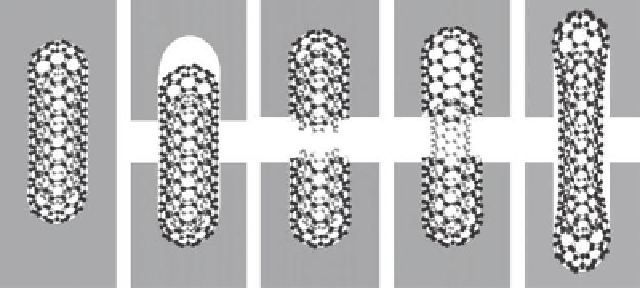Biomedical Engineering Reference
In-Depth Information
(a)
(b)
(c)
(d)
(e)
FIGURE 18.2
(a) Initial state of carbon nanotubes (CNTs) in matrix. (b) Pull-out resulting
from weak interfacial adhesion. (c) Rupture of CNTs resulting from strong interfacial adhe-
sion plus extensive/fast local deformation. (d) Telescopic pull-out due to stronger interfacial
bonding than van der Waals between the tube layers. (e) Crack bridging and partial debonding
of the interface. (Reprinted from
Compos. Sci. Technol
., Gojny, F. et al., Influence of different
carbon nanotubes on the mechanical properties of epoxy matrix composites: A comparative
study, 2300-2313, Copyright 2005, with permission from Elsevier.)
free CNT fiber (Table 18.1). This finding may suggest less of a “fiber” toxicology
basis for polymer-CNT composites under abrasion scenarios. Furthermore, adding
to the complexity of predicting release, the bonding between the CNT and the matrix
may change significantly if surface modifications such as -OH or -NO groups are
added to the CNT (Kingston et al. 2014).
Stressors in addition to mechanical forces can also be thermal or chemical reac-
tions influencing the matrix material as well as the CNT. Thermal stress in particular
may occur along with mechanical stress during sanding as mentioned by Kuhlbusch
and Kaminski (2014). Friction forces lead to heating of the sanded material as is
sometimes seen during wood sanding and the resulting smoke. The effect of heat-
ing by mechanical forces on the likeliness of release has not been studied in detail
thus far.
Examples of further release processes during the lifecycle of conductive plastics
are the accidental combustion, incineration, and shredding at the end of the lifecycle
as well as weathering if left in dumps or in the environment. Table 18.1 presents a
broad overview on release scenarios and study results.
Three kinds of information are essential to correctly address the potential risk of
added CNTs in polymer composite for a particular release scenario: (1) quantitative
characterization of particles released, including minimum detection levels, relevant
to the added CNT; (2a) transformations between release and exposure, allowing
quantitative characterization of the CNT-related particles at exposure points, or
(2b) measurement of CNT-related particles at the point of exposure; and (3) dose
response for the CNT-related particles reaching individuals at the point of exposure.
The release rate and the transformation and transport in the environment determine
the exposure, whereas the type of particles (e.g., CNTs still embedded in the matrix

Search WWH ::

Custom Search